Updated: 22-Jul-2021
This company was founded by Sherman Mills Fairchild, manufacturer of cameras for aerial photogrammetry, with the F-1 camera as an emblem.
-In 1925 he joins with Harold-Caminez to develop the Caminez 447 engine.

"Fairchild logo"
-It all begins in the year mentioned above, when he forms Fairchild Aviation Mfg. Co. and Fairchild-Caminez Eng. Corp. subsidiary dedicated to the manufacture of this interesting engine.
-The engine has a simple appearance, like any other radial engine, but internally it had a double cam device instead of a crankshaft.
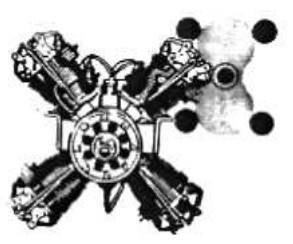
"Caminez's idea"
-The shown 135 hp engine was produced in an unusual way: the double cam in 8-shape and the connecting rods were replaced by rollers under the pistons that drove them.
-To work properly, the pistons were attached to some "links" or rods so that the four rollers were always in contact with the double cam.

"Caminez 135 HP"

"Caminez schematic diagram"
-There were Caminez engines of 80 hp, and of 120 hp like the 447B from 1927 with 4 cylinders.
-Or the 120 hp 447C from 1928. Both with a total displacement of 447 cu. in. There was also an 8-cylinder that was the result of coupling two 4-cylinder Caminez together.
-Again a picture of the Caminez model, in one of its first versions, the 447B that gave 142 hp at 1,120 rpm.
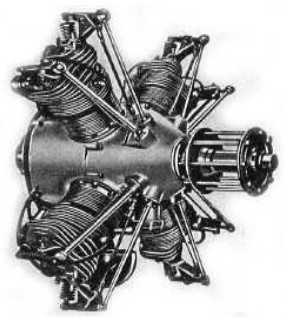
"Fairchild Caminez 447B"
-As we know from the above text, they do not have a crankshaft but a pair of double levers or lobes in the shape of an "eight" and which is driven by the piston rollers, linked by small connecting rods or links.
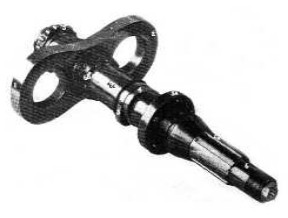
"Caminez crankshaft"
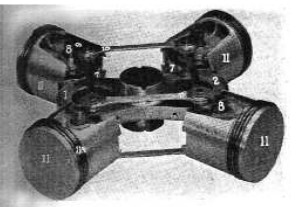
"Assembly of pistons, cams and links"
-The links connect the pistons so that they adapt continuously over the lobes of the "crankshaft".
-The pistons have a roller inside.

"Operation diagrams"
-In the first models we can see that the valve rockers are driven by individual rods, passing to a simplified system in the following illustration of an engine exposed in a showcase at Brodhead Airport, in Wisconsin.
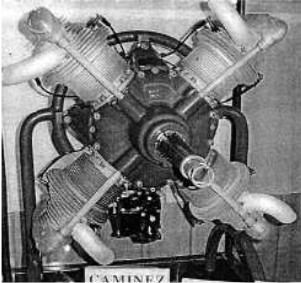
"Caminez en Brohead, WI"
-Through the Fairchild Engine Div. they built engines like the English air-cooled 5-cylinder, radial engine, the Genet that gave 88 hp at 2,200 rpm. It had 251 cu. in. of total displacement.

"Fairchild Genet"
-They also made the Genet Major I that gave 105 hp.
-It happened that the Fairchild left the engine department in 1932 and transferred it to the American Airplane and Engine Co., a subsidiary of the Aviation Co.
-Before giving it away, the inline 6-cylinder engine "6-390" was designed. In 1930 they were known as Fairchild-Ranger, and as "Ranger Eng. Co.".
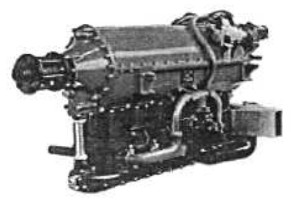
"Ranger 6-390"
-It gave 120 hp at 2,150 rpm and 130 hp at 2,200 rpm, and it had a dry weight of 150 Kgs.
-After a few years it happens that Fairchild repurchases "Ranger Engineering Co." and meets again with its creature, the 6-390 engine.
-The engine had been improved during that time, reaching 145 hp at 2,250 rpm. It was intended for private aviation, and all of its systems were robustly and reliably designed to be as independent as possible from the need for mechanical services.
-It was robust but it had an outdated shape.
-As from this engine, Fairchild develops a line of inverted V-engines: the V-770, with and without supercharging, with and without gearbox, etc.

"V-770SG"
-We see the V-770SG, a 12-cylinder inverted V-engine with a mechanical supercharger at the rear, and the gearbox a little high because of superimposed gears. It gave 420 hp.
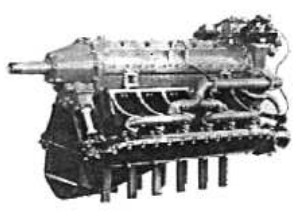
"V-770S"
-The V-770 had an air inlet on the lower front part for cylinder cooling. This engine was supercharged. It is curious to see the distribution of the intake manifold. It gave 350 hp.
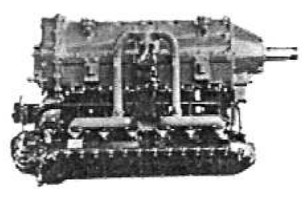
"V-770"
-The V-770 without supercharging nor gear. The carburetor is visible in the center, as well as the unusual intake manifold. Its power was 300 hp.
-The V-770G is the same as the above engine but geared and giving 325 HP.
-There was the simple V-770B with a power of 300 hp and the BS without gear but with supercharger compressor and giving 350 hp at 2,350 rpm.
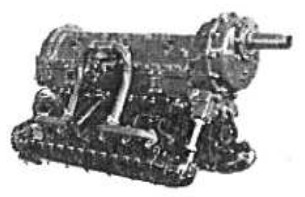
"V-770G"
-At the NASM there is a Fairchild Ranger exposed that did not prosper. It is the XH-1850-2 with 24 cylinders in H and a power of up to 1,000 hp, using 75% of the parts of the initial 6 cylinder engine.
-In the Ranger chapter (see) we will see the other engines such as the L-440 that gave 175 hp at 2,450 rpm.
-Later they worked on the construction of major components for the GE J-47 turbines, as well as on the construction of the V-32 auxiliary piston power plant that drove electric generators of very wide use in civil and military aviation.
-To be able to supply consumable engines for missiles and non-piloted aircraft RPV, UAV, etc., they developed the J-44. (Not to be confused with the current RR-Williams FJ-44).
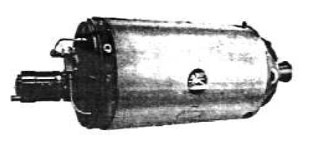
"Fairchild J-44"
-Its cylindrical shape facilitated the fairing of certain structures. The compressor was mixed, i.e., first an axial part and then a centrifugal part. It gave 1,000 lbs at almost 16,000 rpm. Factory reference FT-101E.
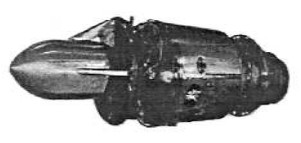
"J-44-R20"
-The J-44 appears more complete in the last figure belonging to the R20 version, in which we see the bullet-shaped cone that includes starter, generator, fuel controls, oil pumps, etc.
-The J-44 we have seen on the Ryan Firebee, guided winged missiles. The J-83 with 2000 lbs, did not enter into production.
-They are the brand's last known engines. Fairchild was dedicated to the construction of structures mainly by acquiring Hiller Helicopters, Republic Aviation, Swearingen, and even Dornier in Europe. In 2002 it caused failure, and disappeared.
From Appendix 6: Regarding the fungible engine for target aircraft, such as J-44 mentioned in the main text, Fairchild was the first to make them in the USA for that purpose.
-An interior design has been located to show it here. The diagonal compressor is characteristic.
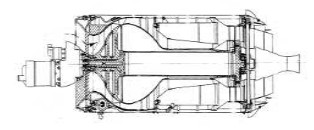
"Fairchild J-44 cross-section"
-This is precisely the schematic diagram of the R-12 variant. The J-44 began its history in the year 1946.
-We continue without locating any photograph of the Fairchild XT-46, projected in the early days for no less than 9,849 SHP (power on the shaft) for the US Navy. The project was aborted shortly after its inception.
-The Fairchild J-44, apart from its installation in missiles, had a curious installation of two tilting engines on each side of this vertical takeoff device. A Turbomeca Palouste (manufactured by Continental) on top of the fuselage
for the various balancing jets. (from Rev. Flight).
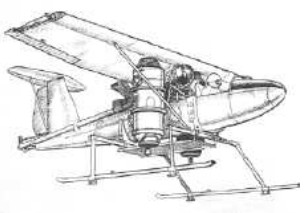
"Fairchild J-44 carrier"
-A Fairchild YJ83-R-3 turbojet engine, with a thrust of 10.9 kN (2450 lbs) powered the XSM-73 missile.

"The Fairchild XSM-73"
It takes off with a booster - below belly and tail - running on Thiokol solid fuel and with 50,000 lbs. of thrust for 3 seconds.
From Appendix 9: Construction of aircraft and engines including the LR-2-RM6 rocket engine.
Engines of FAIRCHILD
Model: 4 cyl. Caminez
Arquitecture: 4-cylinder Radial
Cooling:
Total Displacement:
Bore / Stroke:
Power: 135 HP
Weight:

"Fairchild, Caminez on Brohead, WI"
Model: 6-390B (L-390)
Arquitecture: 6-cylinder In line inverted
Cooling:
Total Displacement:
Bore / Stroke:
Power: 130 HP @ 2200 rpm
Weight: 150 Kg

"Fairchild, Ranger 6-390"
Model: 6-410B(L-410)
Arquitecture:
Cooling:
Total Displacement:
Bore / Stroke: x
Power:
Weight:
Model: 8 cyl. Caminez
Arquitecture:
Cooling:
Total Displacement:
Bore / Stroke:
Power:
Weight:
Model: Genet, 5 cyl. radial (Lic.)
Arquitecture: 5-cylinder Radial
Cooling: Air
Total Displacement: 251 cu. in.
Bore / Stroke:
Power: 88 HP @ 2200 rpm
Weight:
They also made the Genet Major I that gave 105 hp.

"Fairchild Genet"
Model: J-44
Arquitecture: Turbojet
Compressor/s:
Combustion chambers:
Turbines:
Power / Thrust: --- / 1000 Lbf
Weight:

"Fairchild, J-44-R20"
Model: J-63
Arquitecture: Turbojet
Compressor/s:
Combustion chambers:
Turbines:
Power / Thrust:
Weight:
Model: J-83
Arquitecture: Turbojet
Compressor/s:
Combustion chambers:
Turbines:
Power / Thrust: --- / 2000 Lbf
Weight:
Model: L-390
Arquitecture:
Cooling:
Total Displacement:
Bore / Stroke: x
Power:
Weight:
Model: L-410
Arquitecture:
Cooling:
Total Displacement:
Bore / Stroke: x
Power:
Weight:
Model: LR-2-RM6
Arquitecture: Rocket engine
Chambers:
Fuels:
Feed System:
Ignition:
Thrust:
Weight:
Model: V-770, -GV, SGV
Arquitecture: 12-cylinder Inverted V-engine
Cooling:
Total Displacement:
Bore / Stroke:
Power: 420 HP
Weight:
V-770SG: 420 HP
V-770B: 300 HP
V-770BS: 350 HP
V-770G: 325 HP

"Fairchild, V-770S"
Model: XH-1850
Arquitecture: 24-cylinder H-Engine
Cooling:
Total Displacement:
Bore / Stroke:
Power: 1000 HP
Weight:
Model: XT-46
Arquitecture:
Compressor/s:
Combustion chambers:
Turbines:
Power / Thrust: / ---
Weight:
Model: YJ83-R-3
Arquitecture: Turbojet
Compressor/s:
Combustion chambers:
Turbines:
Power / Thrust: --- / 2450 Lbf
Weight:


